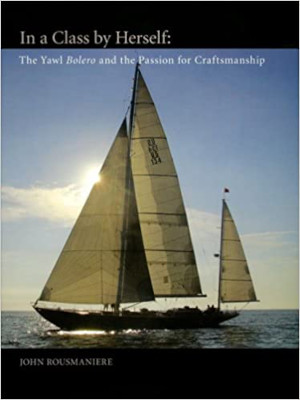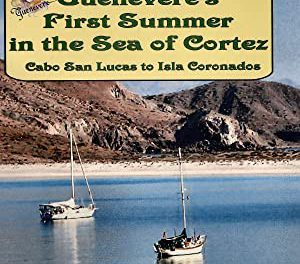
The sailing vessel Bolero is the centerpiece of this gorgeous book and she deserves such an honor. Though other boats with great records melted into the ooze of some obscure boatyard, the sheer beauty of Bolero under sail kept her from that ugly fate. Again and again she was resurrected from neglect, decay, and general decrepitude by those who still saw her beauty, even in her worst moments.
Much history is woven within and around the story of Bolero‘s birth, greatness, decline and resurrection — histories of the designers who conceived her and of the owners whose cash made it all possible, histories of famous boatyards and craftsmen. Some are people whose names GOB readers might recognize: Cornelius Shields, Ted Turner, Henry S. Morgan (of Morgan Stanley), to name a few.
This is a story of the rich and famous, those who sailed very large and very expensive boats. One story tells of a race where a crewmember of a rival boat spotted a trail of artichoke leaves and instantly knew it could only have been left by Bolero, whose famous galley cook was preparing dinner.
But wealthy owners aren’t the only heroes here. There are the “back stories” of designers Olin and Rod Stephens, of the famous Henry Nevis Boatyard, and the craftsmen who were crucial in building Bolero. And because the world of big wooden sailing boats was (is) such a small one, most of America’s hero-designers walk in and out of this book: Bruce Kirby, John Alden, Nathanael and Halsey Herreshoff, etc.
Rousmaniere is excellent when describing the exciting races between Bolero and Baruna, another Sparkman and Stephen’s boat of similar dimensions, often long ocean races — Newport to Annapolis, the Bermuda races, etc. The virtue of these stories is the crewmembers on-board recollections of the fast and furious action and the sheer size and power of these boats. One crewmember remembers ” . . . Bolero‘s bronze winch literally exploded under the strain and bronze pieces flew everywhere . . . anything that flopped on Bolero could kill you on impact . . . the only thing on Bolero I could lift without a winch was a sandwich . . .”
There are interesting capsule histories of the Sparkman and Stephens naval architecture firm and the Henry Nevins Boat Yard, both of whom catered to the building/rebuilding of large sailing vessels. I admire the Rod Stephens quote: ” . . . the best work is done by people who are fanatical and fanatics are not known for their flexibility.” And, of course, that is what creates the conflicts and thus the stories herein.
John Nicholas Brown commissioned Bolero‘s construction, but it was his wife, Anne Seddon Kinsolving, who influenced the design of Bolero in crucial ways and “made John Nicholas Brown a sailor,” according to Rousmaniere. After a succession of owners, Bolero disappeared until Ed Kane found her — deserted, dismantled, and derelict, up a muddy creek in Florida.
Kane and his wife, Marty Wallace, restored Bolero to full glory once again, with Marty taking the lead. Kane himself says his biggest joy was to get syndicates together and watch the intrigue of interacting personalities, while “Marty is the builder and the artist . . . . She loves tearing things apart and rebuilding them . . . I’m not a project person.”
They rebuilt Bolero to race with a smaller crew, adding power winches and roller furling, much against the objections of traditionalists. The grand old lady did race again. In the 2004 season she took six firsts and four seconds.
All in all, John Rousmaniere’s book is an interesting read and thoroughly gorgeous to look at. If you’re looking for books on knock-em-dead-handsome old boats with downright beautiful pictures, you’ll like this one.
In a Class by Herself: The Yawl Bolero and the Passion for Craftsmanship by John Rousmaniere (Mystic Seaport, 2006; 168 pages)




